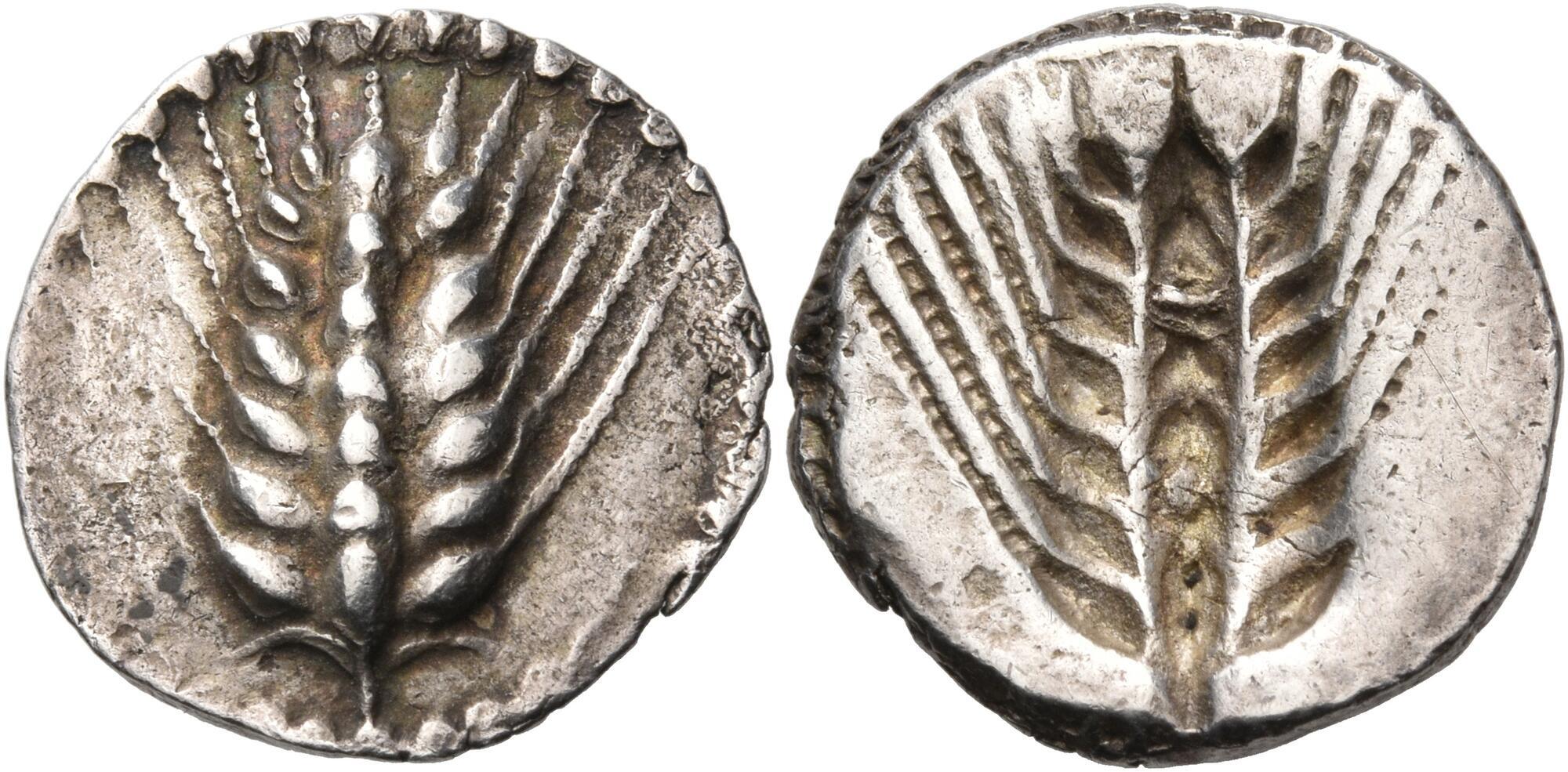Metapontum, silver, 3rd didrachms (530-510 BCE)
From SILVER
530 BCE - 510 BCE Silver 1,877 kg
Description
| ObverseInscription or printing placed on the obverse.: | META (Greek).Ear of barley with seven grains, around, border of dots |
| ReverseInscription or printing placed on the reverse.: | Ear of barley with seven grains, all incuse, rayed border |
Mint and issuing power
| MintIdentifies the place of manufacture or issue of a numismatic object.: | Metapontum | Ancient regionAncient region.: | Lucania | Modern countryModern country: Italy | AuthorityIdentifies the issuing power. The authority can be "pretended" when the name or the portrait of X is on the coin but he/she was not the issuing power. It can also be "uncertain" when there is no mention of X on the coin but he/she was the issuing power according to the historical sources: |
Chronology
| FromIdentifies the initial date in a range assigned in a numismatic context. | 530 BCE | toIdentifies the final date in a range assigned in a numismatic context.. | 510 BCE | PeriodTime period of the numismatic object.: Archaic until 480 BC |
Physical description
| MetalThe physical material (usually metal) from which an object is made.: | Silver |
Median weightMedian of the weights of numismatic objects (in grams). in grams | 2.60 | DenominationTerm indicating the value of a numismatic object. Examples: tetradrachm, chalkous, denarius.: | 1/3 stater, 1/3 nomos | StandardStandard.: |
Image

RQMAC 3 - Metapontum, silver, trite, 530-510 BC.jpg [1]
References
| Die study referencePublication of the study: | Noe - Johnston 19841Noe - Johnston 1984, n° 28-33, 48-9, 51-3, 79-84, 99, 106-9, 154a, Noe 19272Noe 1927, Noe 19313Noe 1931 | ||
| Coin series referenceReference to coin series study: | Sear I4Sear I, n° 236, RQEMAC5RQEMAC, n° 3 | ||
| Coin series web referenceCoin series web references: | |||
Obverse dies distribution
| FrequencyFrequency of specimen in distribution. ᵖ | Number of obversesNumber of obverse dies. ᵖ (o) | % (o) | Number of coinsNumber of coins. (n) | % (n) | Die nameName(s) of the die(s). |
| 1 | 9 | 39.13 | 9 | 18.75 | 28, 31, 52, 53, 79, 80, 82, 109, 154a |
| 2 | 8 | 34.78 | 16 | 33.33 | 29, 33, 48, 49, 51, 84, 107, 108 |
| 3 | 3 | 13.04 | 9 | 18.75 | 30, 81, 83 |
| 4 | 2 | 8.7 | 8 | 16.67 | 99, 106 |
| 6 | 1 | 4.35 | 6 | 12.5 | 32 |
| Total | 23 of 23 | 100 | 48 of 48 | 100 |
Reverse dies distribution
no distribution is available
Quantification
| Number of obversesNumber of obverse dies. ᵖ (o) | 23 | Number of singletons (o1)The number of singleton coins. ᵖ | 9 |
| Number of reverse diesNumber of reverse dies. (r) | Number of coinsNumber of coins. (n) | 48 | |
| Coins per obverse dieNumber of coins per obverse die. (n/o) | 2.09 | Coins per reverse dieNumber of coins per reverse die. (n/r) | |
| Reverse per obverse ratioRatio of obverse dies divided by reverse dies. (r/o) | Percentage of singletons (o1)number of coins (n) divided by the number of singletons (o1) ᵖ | 39.13 % | |
| Original number of dies (O) (Carter 1983 formula)The estimation of the number of coins according to Carter 1983 ᵖ | 36.1 | Coins struck if 20,000 as average productivity per dieCoins made if the average productivity for obverses (according to Carter) is 20,000. ᵖ | 722,000 |
| Original number of dies (O) (Esty 2011 formula)The estimation of the number of coins according to the singleton formula in Esty 2011 ᵖ (O) | 44.16 | Survival rate if 20,000 as average productivity per dieSurvival rate if average productivity is 20,000. ᵖ | 0.00007 |
| Coverage (o = % of O) (Esty 1984 formula)Esty 1984 - coverage (% of O) ᵖ (o = % of O) | 81.25% | Die productivity if survival rate 1/2,000Average productivity if survival rate is 1/2,000. ᵖ | 2,659.28 |
| Weight of silver (in kg) if 20,000 coins per die (O = Carter formula)Carter 1983 * Median weight * 20000 (*10 if gold or electrum) ᵖ | 1,877 kg <br /> 1,877 kg | Die productivity if survival rate 1/5,000Average productivity if survival rate is 1/5,000. ᵖ | 6,648.2 |
Remarks